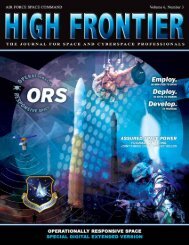Schriever Wargame 2010 - Air Force Space Command
Schriever Wargame 2010 - Air Force Space Command
Schriever Wargame 2010 - Air Force Space Command
- No tags were found...
You also want an ePaper? Increase the reach of your titles
YUMPU automatically turns print PDFs into web optimized ePapers that Google loves.
The two problems with the current model are:<br />
1. It will break down in a contested environment. As simultaneously<br />
capacity is reduced through attack or jamming<br />
and there is a clamor for bandwidth from militaries,<br />
media, and commercial interests due to crisis, DoD will<br />
likely find that it cannot secure the service required.<br />
2. It passes up a golden opportunity to greatly reduce cost by<br />
leveraging industry’s more efficient acquisition model.<br />
A better model would be to establish serious long-term contracts<br />
directly with satellite operators. These contracts could<br />
include clauses that would give DoD first rights to bandwidth<br />
during crisis (at a premium) and would lower peacetime costs<br />
through bulk buy. DoD should give industry specific requirements,<br />
such as anti-jam, in these contracts and guarantee a<br />
fixed level of purchase for a fixed number of years. This action<br />
would free industry to design and launch systems tailored to<br />
DoD’s needs at greatly reduced costs relative to acquiring additional<br />
government systems.<br />
International Traffic in Arms Regulation – Think the<br />
Traditional <strong>Air</strong> <strong>Force</strong> that Flies Planes<br />
When our pilots encounter F-16s flown by a hostile nation,<br />
they have the advantage of understanding the characteristics of<br />
the system that they are facing—because we built it. This is not<br />
true facing MiGs or Mirages. Why on Earth would we not want<br />
the same advantage in space In many ways, exporting satellites<br />
is better than exporting planes/tanks/ships/etc.—they tend<br />
to be on orbit when delivered and so cannot easily be reverseengineered.<br />
Export restriction on all but the most sensitive spacecraft<br />
systems should immediately be lifted and encouraged as much<br />
as possible. There is an added benefit in that nations that purchase<br />
our systems will be more likely to share them back with<br />
us in the case that ours are destroyed.<br />
<strong>Schriever</strong> <strong>Wargame</strong> 2012 – Think Tactical<br />
Five <strong>Schriever</strong> games in a row have provided great insight<br />
into the operational level of a space conflict. The placement of<br />
the <strong>Schriever</strong> V <strong>Wargame</strong> and SW 10 a year apart with common<br />
leadership between the two was highly successful—SW<br />
10 was in many ways a much richer, more nuanced version of<br />
the <strong>Schriever</strong> V <strong>Wargame</strong>. What is missing is the tactical aspect.<br />
The <strong>Schriever</strong> <strong>Wargame</strong> 2012 should be held in conjunction<br />
with a set of space exercises to explore the tactical nature<br />
of the game.<br />
<strong>Space</strong> Acquisition – Think Depth, Local Empowerment,<br />
and Stability<br />
The once mighty space acquisition system producing the<br />
greatest wonders of the classified security community, and directly<br />
responsible for America’s dominant information advantage,<br />
is now seen in many parts of the Pentagon as the worst<br />
performing of the troubled military procurement systems. “Oh,<br />
the most expensive page in DoD,” a recent offhand remark by<br />
one of DoD’s highest ranking officials when offered a one page<br />
summary of space programs by the <strong>Air</strong> <strong>Force</strong> in the presence of<br />
this author, illustrates the climate.<br />
Our collective inability to halt this decline has led to highly<br />
fragile systems and is pricing us out of the space business.<br />
For example, DoD once paid between $100 - $200 million a<br />
year to field a weather satellite program in two orbits (Defense<br />
Meteorological Satellite Program [DMSP]). Under National<br />
Polar-orbiting Operational Environmental Satellite System<br />
(NPOESS), it would have paid $800 million to $1 billion for<br />
that same privilege. With DMSP, we routinely had multiple<br />
vehicles ready for launch, with NPOESS, we were one launch<br />
failure from a multi-year gap in capability.<br />
Much as we would like to wish it away, building satellites<br />
to survive the rigors of space without any human intervention<br />
is more art than science. Highly complex, with little design<br />
margin, unforgiving, temperamental, with thousands of oblique<br />
rules learned the hard way—from past failures. Building a satellite<br />
involves a thousand decisions any one of which can manifest<br />
itself either as a failure of the entire system on-orbit or as<br />
rework during the integration and test phase when a satellite’s<br />
“burn rate” is at its highest.<br />
The following difficult, perhaps impossible, changes are required<br />
to regain our ability to pioneer an Apollo, or a Corona:<br />
1. Government Program Office personnel and leadership<br />
need depth, not breadth. Ideally, a SPO director and<br />
his/her direct reports will spend his/her entire career not<br />
just in space acquisition but in the acquisition of space<br />
systems of a specific mission type (i.e., infrared missile<br />
warning or protected satellite communications).<br />
2. Contractor program office personnel and leadership need<br />
depth, not breadth. We must acknowledge to ourselves<br />
that there really isn’t competition in the space industry<br />
base. With two and one-half large primes, none “allowed<br />
to fail” and the government picking up the tab for the inevitable<br />
overruns, the only competition is that between<br />
creative proposal writers and innovative costing. Competition<br />
at the second and third tier suppliers is often nonexistent.<br />
There are few if any examples of an incumbent<br />
contractor/government team foundering on a follow-on<br />
Ideally, a SPO director and his/her direct reports will spend his/her entire career not just<br />
in space acquisition but in the acquisition of space systems of a specific mission type (i.e.,<br />
infrared missile warning or protected satellite communications).<br />
High Frontier 52











